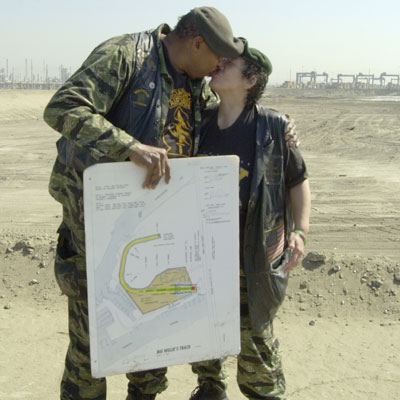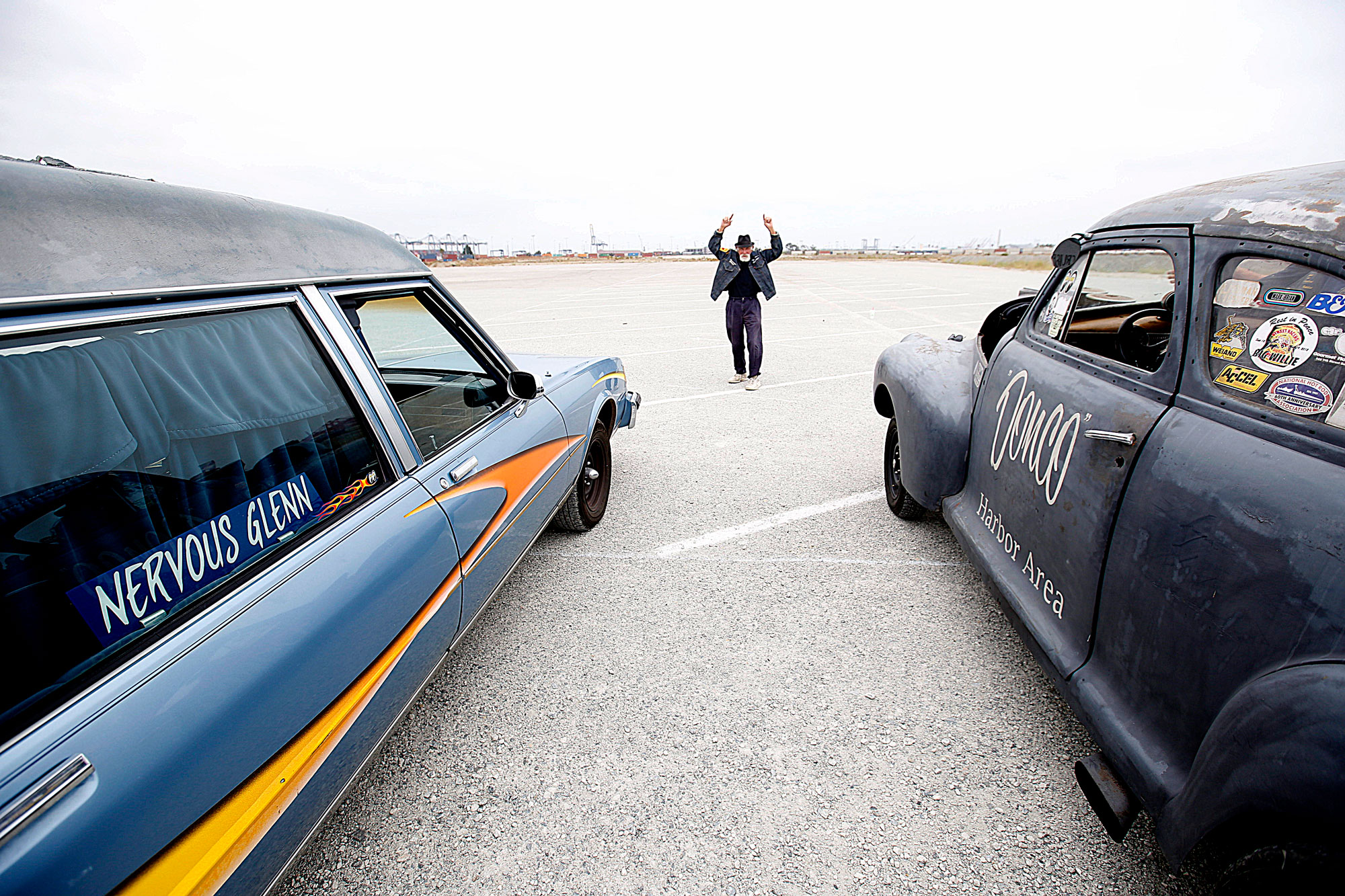Listen now
Subscribe to the podcast
As the darkness of the 1980s engulfed South Los Angeles, Big Willie Robinson found himself without a racetrack and his influence in the streets diminished. But after the city burned again, he seized a chance to start anew — though could things ever really be as they once were?
See more
‘King of the street’
In his heyday, Brotherhood of Street Racers leader Big Willie Robinson could command the attention of hundreds of racers. He’d don his derby hat, hop up into the back of a flatbed truck and address the masses with a bullhorn. Drag Racing magazine even dubbed him "king of the street."
Darkness falls on Brotherhood Raceway
But by the late 1980s, Willie no longer ruled the scene. That's because Brotherhood Raceway Park was shut down in 1984 — at a time when L.A. could have used the track. Hard-core drugs, especially crack, were causing chaos in parts of South Los Angeles. That’s the roughly 50-square-mile section of the city that includes Watts and the area formerly known as South Central. And Big Willie, now middle-aged, was powerless to stop the influx of narcotics.
A new tragedy
And if L.A. was unforgiving in the 1980s, the ’90s were about to get worse. New riots would soon overtake South L.A. In April 1992, the four Los Angeles police officers who viciously beat Rodney King were cleared of charges related to excessive force. The videotaped beating played constantly on TV. South L.A. erupted. Almost 30 years after the Watts riots, Big Willie could only watch as another mess unfolded. His track was closed. He didn’t have the rapport he’d had with the Los Angeles Police Department in the late 1960s, a time when he helped keep the peace after Martin Luther King Jr.'s assassination.

In his own words
Big Willie said the 1992 riots were a catalyst for other trouble.
Out of the ugliness, an opening
Just as the Watts riots created an opening for Willie to be a peacemaker, it took another desperate time to lead to a second chance. But it wouldn’t unfold exactly like before. Mayor Tom Bradley, Willie’s benefactor for more than 20 years, had decided to not seek a sixth term. Still, Willie had an in with Bradley’s Irish American successor, Richard Riordan. Willie’s connection? Otis Chandler, who by now had stepped down as publisher of the L.A. Times. The tycoon wrote letters to the new mayor and others advocating on Big Willie’s behalf as the racer renewed his effort to reopen Brotherhood Raceway. Chandler’s support came at a pivotal time in 1993, just ahead of a crucial meeting at which the L.A. Harbor Commission would discuss a potential comeback for the racetrack.

READ MORE

Back in business
Brotherhood Raceway reopened in November 1993. The deal the Harbor Commission struck with Willie wasn't great for the Brotherhood of Street Racers — the group could be booted when the city needed the land back. But it was good enough for the time being. Brotherhood member Eddie Meeks, serving as the Brotherhood's official photographer, documented the action out on Terminal Island.


Community engagement
After the whole world saw cops beat Rodney King, it was more important than ever to have a haven where officers could try to connect with their community. And Brotherhood Raceway stood out as a rare place where that could happen. Publications, including The Times, took notice. Former Times columnist Al Martinez wrote about the sense of brotherhood at the raceway in 1993. Scott Graham, a Los Angeles County sheriff's deputy, also said that while the track was open, racing on the streets all but disappeared, because people had a place to go again. “The violence at the time dramatically dropped,” Graham said. He heads a nonprofit community outreach program called LASD Motorsports that’s focused on strengthening trust between law enforcement and the public. Like Willie, Graham has used cars to break down barriers — he drives an eye-catching dragster done up to look like a deputy's cruiser, down to the flashing lights on the roof.

READ MORE
Things take a turn
Although Brotherhood Raceway again coursed with energy, Bradley was gone. And there just weren’t enough public officials who shared Willie's vision — especially when things went wrong. A handful of incidents were well publicized, painting the track in a bad light. There was, for instance, a shooting involving two friends who were arguing about a female companion. Willie said that one of the men made a crude sexual remark about the woman, enraging the other. “And so that made him go into his pocket and pull his .380 and pop off four rounds,” Willie said. “But by the grace of God, nobody got seriously hurt.” There was also a death at the track. In 1994, Newman “Mack” Perry was killed in a crash. According to a memo written by a harbor commissioner, Perry’s car was so fast that it usually deployed a parachute to slow down. But on this day, and on this pass, his vehicle continued to accelerate after crossing the finish line, and the parachute didn’t open.
Documenting the trouble
Racetracks are dangerous places. Brotherhood Raceway wasn’t the first to deal with a deadly crash — far from it. It’s also not the only local one where a shooting has occurred. In 2002, a dispute between two spectators at Irwindale Speedway left one dead and two others wounded. But after the incidents at Brotherhood Raceway, things did get more difficult for Willie and the Brotherhood. The Harbor Commission was documenting the trouble — and neighboring tenants at the port, like Hyundai and Mitsubishi, expressed safety concerns. Among the L.A. Harbor Department's files on the track is an incident report, shown here, that gives a sense of the issues in play.

READ MORE
Willie loses his cool
After nearly a decade without a track, Big Willie had finally reclaimed his perch, and now the authorities wanted him to operate by the book. That meant racing had to stop at 8 p.m. Sharp. A dustup over this was documented in an LAPD report contained in the Harbor Department files. According to the write-up, on this night in 1994, a fire inspector was on hand to make sure the racing ended on time. But Big Willie was fed up. According to the report, he exploded.

READ MORE

It's over
The Harbor Department shut the track down a year later, in October 1995, saying it needed the land on Terminal Island for port-related business. Brotherhood member Fabian Arroyo remembers what it felt like when it became clear a reopening of the raceway wasn’t likely. “There's anger and frustration and sadness all in one,” he said. “There's a lot of sadness. Sadness that my kids can't go there. That track could’ve changed a lot of people’s lives.” Willie’s wholesome vision of Brotherhood Raceway as a place where all sorts of people could come together in peace may have made sense in the 1970s. But, two decades later — given the climate in L.A., and without a strong government ally — it felt like a pipe dream. These days, the vacant property is a barren expanse, taunting the racers who once wowed crowds of thousands there.
The Brotherhood returns
Any trace of Brotherhood Raceway was erased long ago — or "buried," as Arroyo said. Terminal Island hasn’t been home to a drag strip in 24 years. It’s been seven years since Big Willie died. Twelve years since his wife, Tomiko, died. But in 2018, a handful of Brotherhood members returned to the former site of Brotherhood Raceway with the help of The Times, which arranged the visit. Making this day happen wasn’t easy. The trip required approval from the chief of the Los Angeles Port Police, and an escort to get on site — in part because the former home of Brotherhood Raceway is fenced in and encircled by a rail line.

Creating a new mythology on the fly
They certainly didn’t ask for permission, but it soon became clear that the Brotherhood members wanted to race. As a handful of cops watched from the vicinity of their squad car, the racers, Arroyo and Donald Galaz, quickly got into formation not far from where the drag strip's original starting line had been. As the two cars raced down the road, they kicked up tons of dust. It billowed high in the air, making eyes water and blanketing the site of Brotherhood Raceway for just a moment, giving it a dream-like sheen. The salt air. The chirp of the gulls. The burbling idle of Galaz's Chevrolet gasser reverberating in the attendees' chests. It could’ve been 1975 or 1983 or 1994. It felt like a moment to commune with the dead. All the people who made this place what it once was. Tom Bradley. Otis Chandler. Tomiko. Big Willie.

Next episode
The Last Race »
Subscribe to the Play Next newsletter to be the first to know when we release new episodes.
Website credits
Reported by Daniel Miller. Digital production by Sean Greene. Edited by Kimi Yoshino. Video production by Myung Chun, Robert Meeks, Jason Neubert and J.R. Lizarraga. Copy edited by Rubaina Azhar. Photography by Myung Chun, Kirk McKoy, Howard Koby and Steve Reyes. Photos edited by Mary Cooney. Research by Scott Wilson. Audience engagement by Tessa Bangs. Additional production by Jessica Perez.
Podcast credits
Reported, written and hosted by Daniel Miller. Produced by Grant Irving. Edited by Catherine Saint Louis. Story supervision by Kimi Yoshino. Executive produced by Jonathan Hirsch. Additional production by Karan Nevatia. Sound design and mixing by Daniel Tureck. Music by Nolan Schneider and Grant Irving. Sound engineering by Mike Heflin. Research by Scott Wilson. Fact checking by Laura Bullard. Copy edited by Rubaina Azhar. Additional audio work by Myung Chun, Jason Neubert and Robert Meeks. Audio rights and clearance by Alan Hagman, Paige Hymson and Erica Varela. Legal work by Jeffrey Glasser. "Larger Than Life" is a production of LA Times Studios with support from Neon Hum Media.

 Apple Podcasts
Apple Podcasts Spotify
Spotify Stitcher
Stitcher